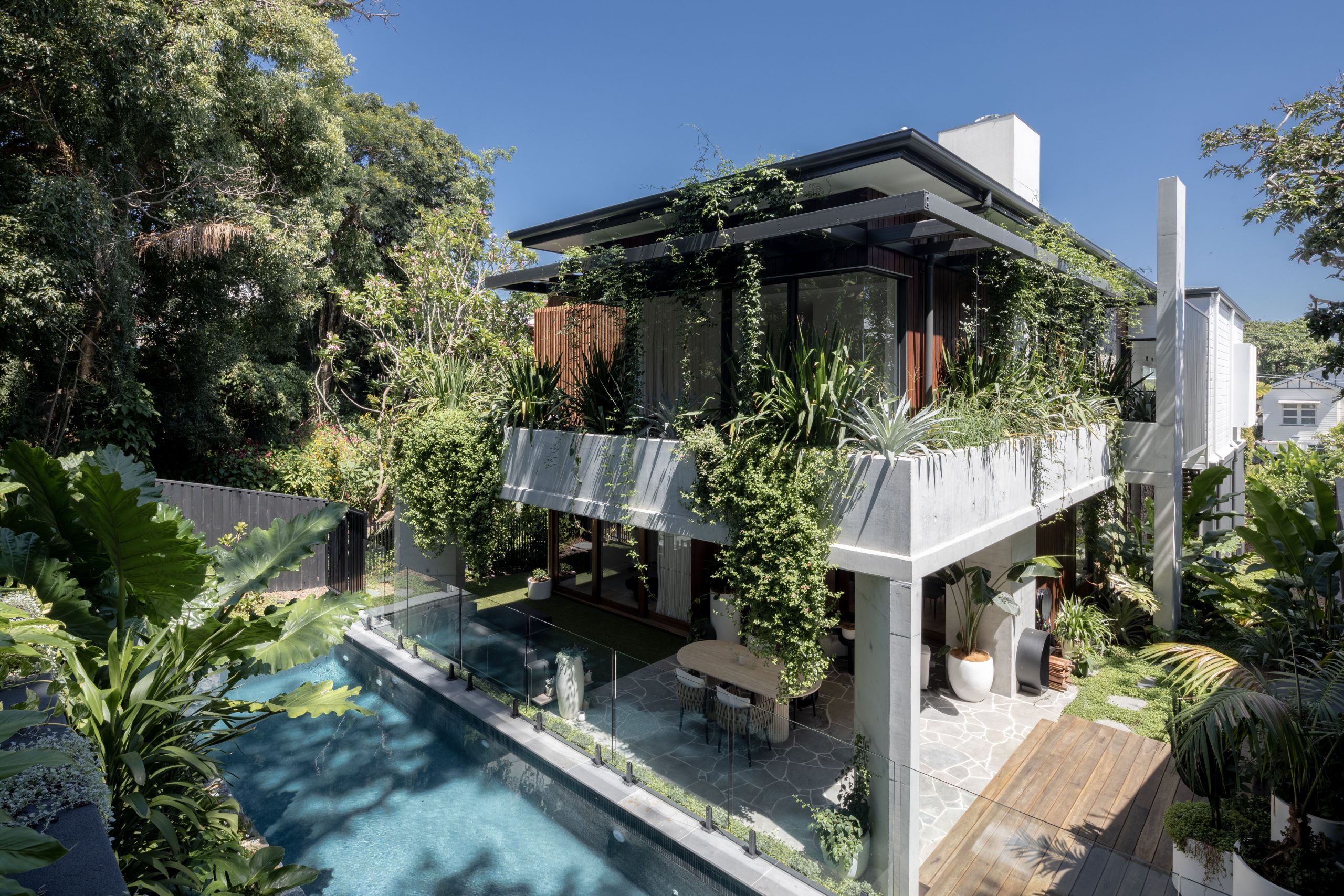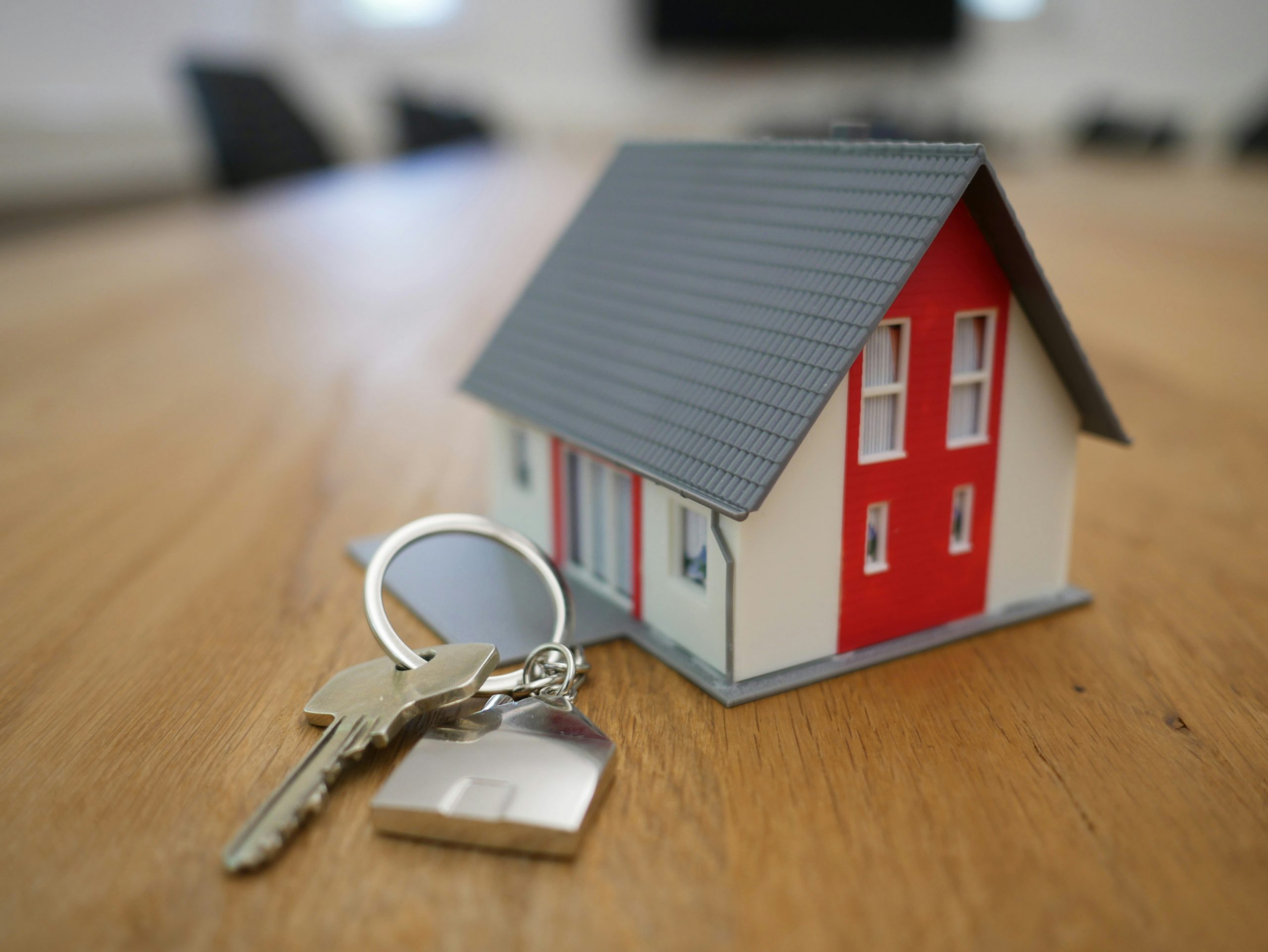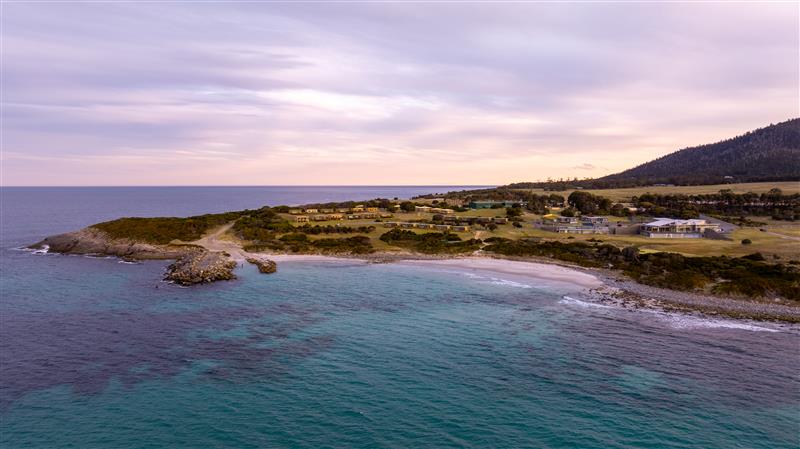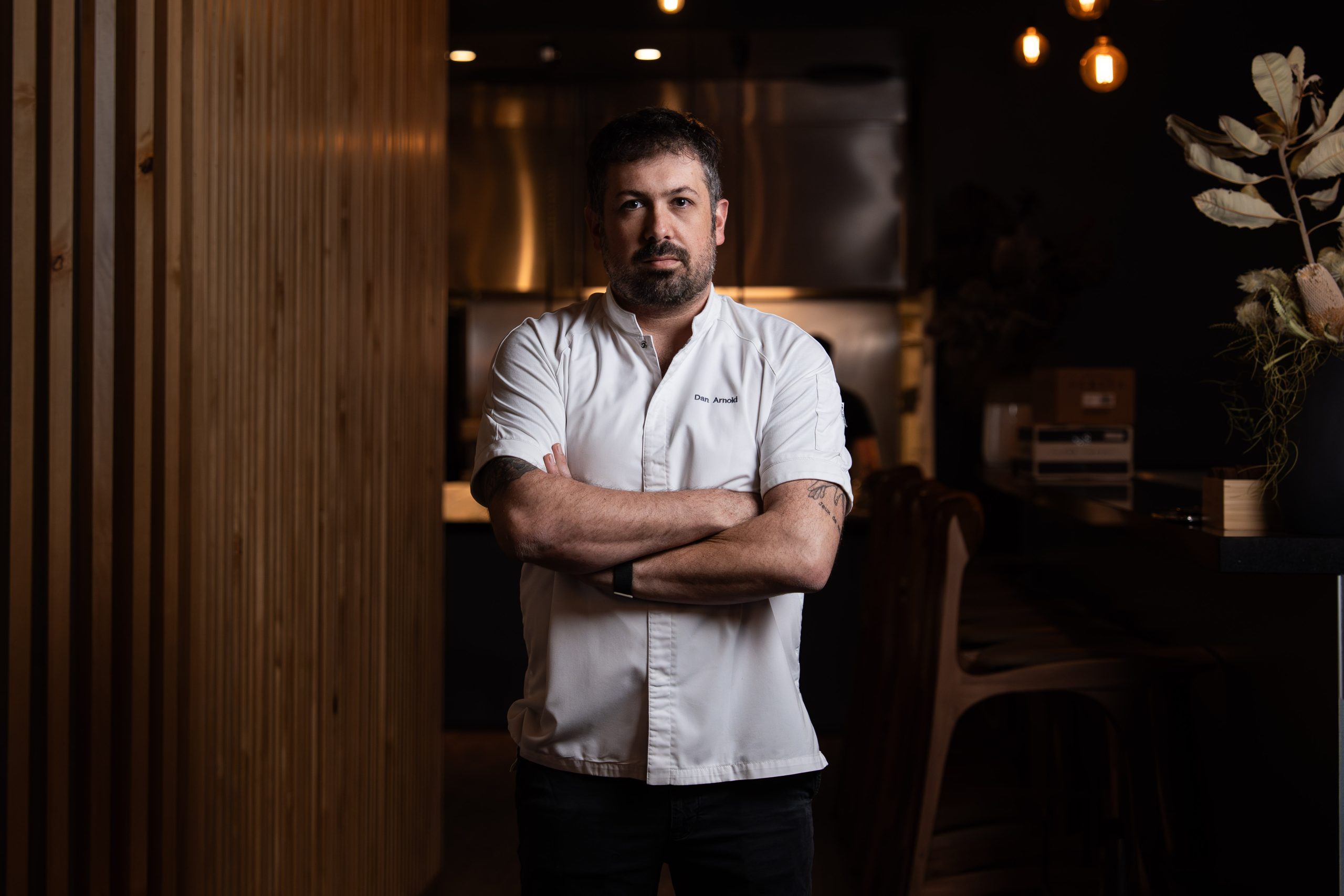The hardworking design feature setting up this Brisbane home for entertaining
It’s business at the front and party at the back in this transformation of a classic Queenslander
T o homeowners in other east coast capitals, the inner suburbs of Brisbane are quite the surprise. Just minutes from the heart of the city, they are consistently populated with traditional Queenslanders positioned on generous sites. So generous, in fact, that the 500sqm or so block that this home in Paddington sits on is considered on the smaller side.
Architect Alexandra Buchanan was called in before the owners had even purchased the property in the highly desirable suburb to see if it had potential for renewal without having to sacrifice its original charm. Still in ‘very original’ condition, the three-bedroom weatherboard cottage had been virtually untouched over the years but was deemed in sound enough condition to make the transition into the 21st century.

Characterised by lightweight timber construction, decorative timberwork and verandas to keep out the sun, Queenslanders are most notable for being built on ‘stilts’. Constructed from the mid 1800s to after WWII, the increased air flow under the house helped to manage the climate, as well as mitigate flood risk and make it easier to build on uneven terrain.
The new owners, who were experienced builders and developers, were keen to let the original house shine while creating a significant contemporary extension at the rear that would make the most of the subtropical environment.
“It was a classic ‘worst house on the best street’ scenario in a tricky spot in the low point on the street,” Buchanan says. “In Brisbane there are overland flow issues which we had to overcome because this house is sitting in a low point.”
As demonstrated by the 2022 floods, Brisbane is on the Brisbane River floodplain. While Paddington is just under 5km from the CBD, it is subject to overland flow flooding which Brisbane City Council defines as ‘run-off that travels over the land during heavy rainfalls’ with depth and impact depending on the prevailing local conditions.
Safeguarding the house against future flooding was a top priority.
“It’s a low set, single-storey house with a lovely big back garden that raked up away from the street at the back of the property,” Buchanan explains.
“It’s on an elevated slab so the water way is still on the lower level under it. We don’t impede the water flow, the house is sitting above it so that you don’t know anything about it at all.”
Rather than continue with the traditional weatherboard construction at the front of the house, Buchanan specified a mix of concrete, stone and natural timber to create the two-storey extension to the rear. At the heart of this is a dramatic void above an open plan living space that takes in the kitchen, dining and living room.
“A lot of the design was about making sure we had good access to natural light while opening up the side of the house,” she says. “That’s why it has that beautiful void space in the heart of the house.
“When you come through the front door it reveals itself to you and it’s quite a dynamic space as the light tracks across it during the day.”
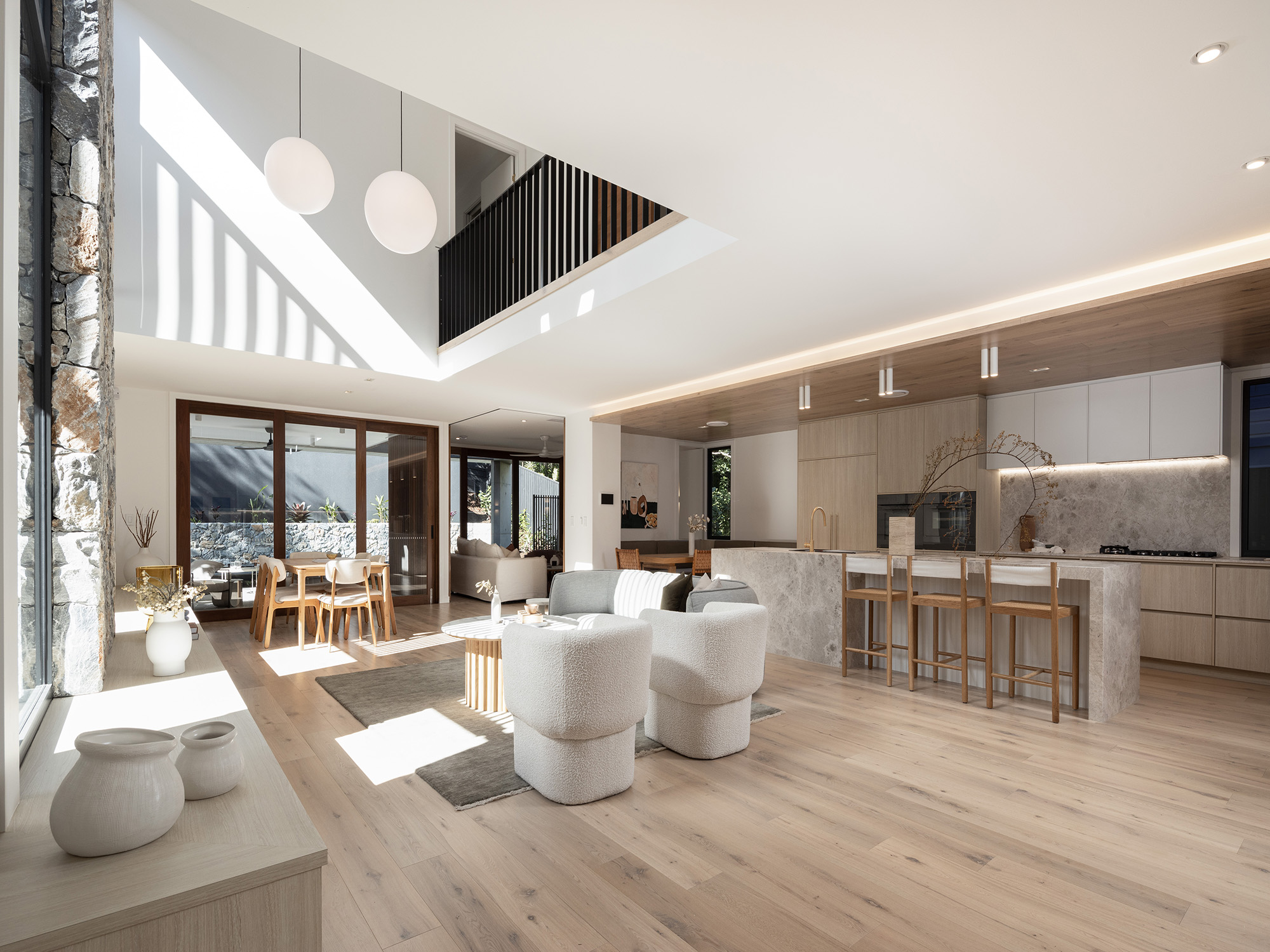
The articulated floorplan includes a second living space on the ground floor, specifically designed to have quite a different feel.
“We wanted to close off the second living space that addresses the garden because it’s a TV space,” Buchanan says. “It’s more intimate with a lower ceiling.”
Upstairs, there’s a library, as well as a spacious balcony off the main bedroom suite overlooking the garden and pool below.
But perhaps the real drawcard is the flow between indoor and outdoor spaces. Using the upper floor as an overhang, Buchanan designed a paved alfresco dining space that leads onto an outdoor living area that almost feels like an internal courtyard. Key to this is a large concrete planter that extends beyond the footprint of the upper floor to wrap around the outdoor living area. Built by master builders BBH Projects, landscaping by local firm Brooke’s Blooms has further enhanced the site by selecting a combination of architectural and hanging plants so that it’s hard to discern where the house ends and the garden begins.
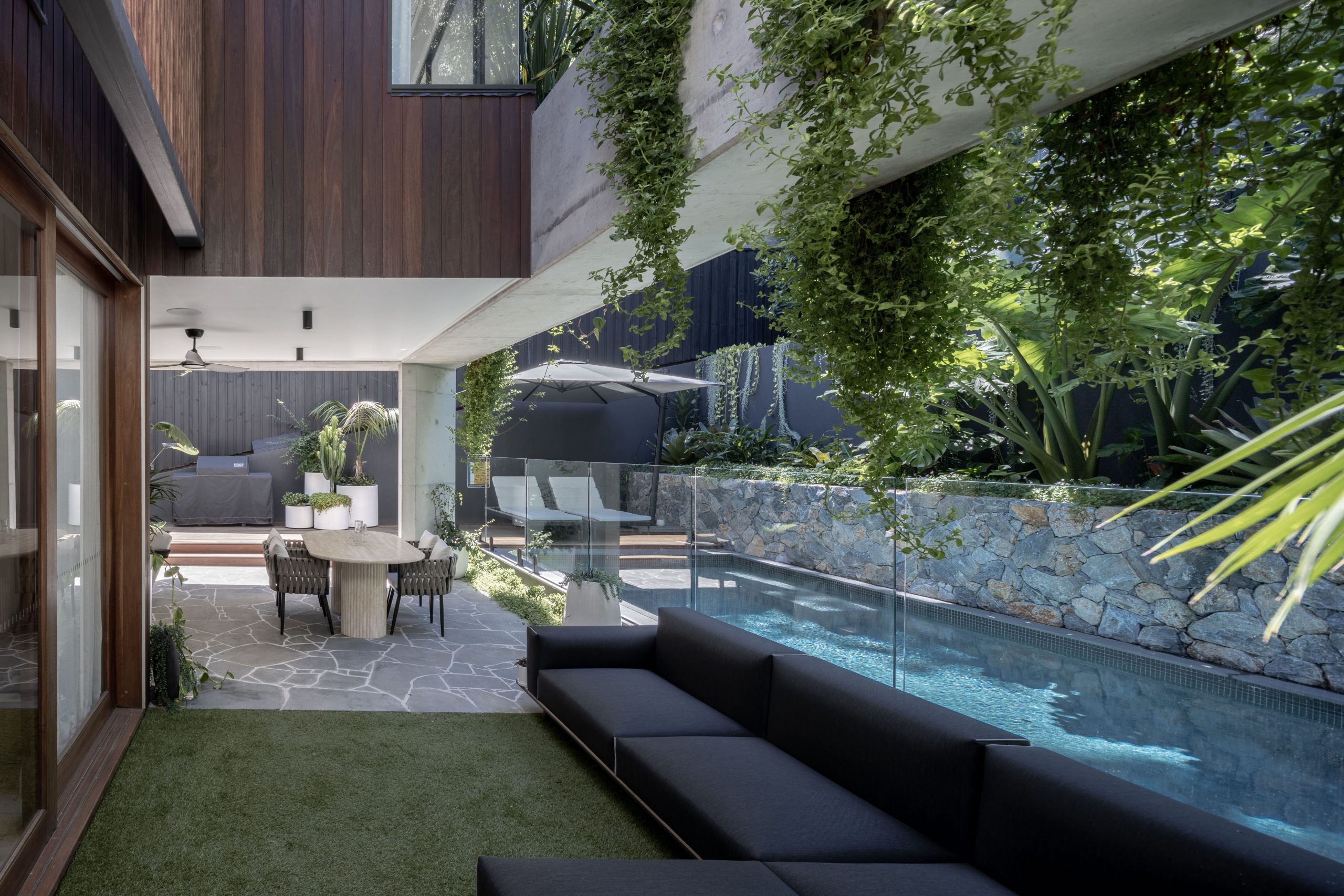
“The brief was very much about the connection to the garden and having as much garden as we could afford them,” Buchanan says. “We live in subtropical Queensland so that indoor/outdoor flow with beautiful cross flow of air was critical.”
With neighbours to both sides and the rear, it was important to lean into the local landscape as much as possible.
“We had to juggle some proximity to the neighbours,” she says. “They had quite a beautiful, lush garden on their block and around them and their neighbour has some beautiful established trees so we made sure to enhance that to provide privacy.”
Taking on the weight of the hanging gardens would not have been possible without concrete.
“The benefits of having that concrete base allowed us to have the planting to carry the site and provide the screening,” she says. “It also allows for an outdoor fireplace which is embedded in that as well. It’s a very hard working element that integrates front and back.”
While visitors to the house are drawn to the dramatic living space and garden, for Buchanan, it’s the quiet moments in this house that please her the most.
“There’s a gorgeous informal meals area off the side which is one of my favourite spots,” she says. “You can imagine informal catch ups with friends happening there with a glass of wine while you’re in the kitchen. It could have been a dead corner but it gave it activation.”
Australia’s housing market defies forecasts as prices surge past pandemic-era benchmarks.
Records keep falling in 2025 as harbourfront, beachfront and blue-chip estates crowd the top of the market.
Australia’s housing market defies forecasts as prices surge past pandemic-era benchmarks.
Australian house prices are surging again, delivering double-digit annual growth months ahead of schedule.
Nationally, the median house price climbed 1.1 per cent in October to $940,000, lifting annual growth to 10.6 per cent, the first double-digit increase since the 2021–22 property boom.
Market Resilience Surprises Analysts
The acceleration comes earlier than expected, according to Ray White Group Chief Economist Nerida Conisbee, who says the milestone was originally forecast for the end of the year.
“Stronger-than-expected October gains and continued tight supply across most markets have pushed growth ahead of schedule,” Conisbee said. “This shows how resilient demand has remained through spring.”
Perth (+14.8 per cent), Brisbane (+12.5 per cent) and Adelaide (+10.8 per cent) continue to lead the charge among capital cities, while Sydney (+8.6 per cent) and Melbourne (+6.5 per cent) show steady, consistent increases.
Regional Markets Extend Their Lead
Beyond the capitals, regional Australia is powering ahead, particularly in the resource states.
Regional Western Australia jumped 16.4 per cent year-on-year, and regional Queensland followed close behind at 14.5 per cent, as population growth and affordability continue to drive demand.
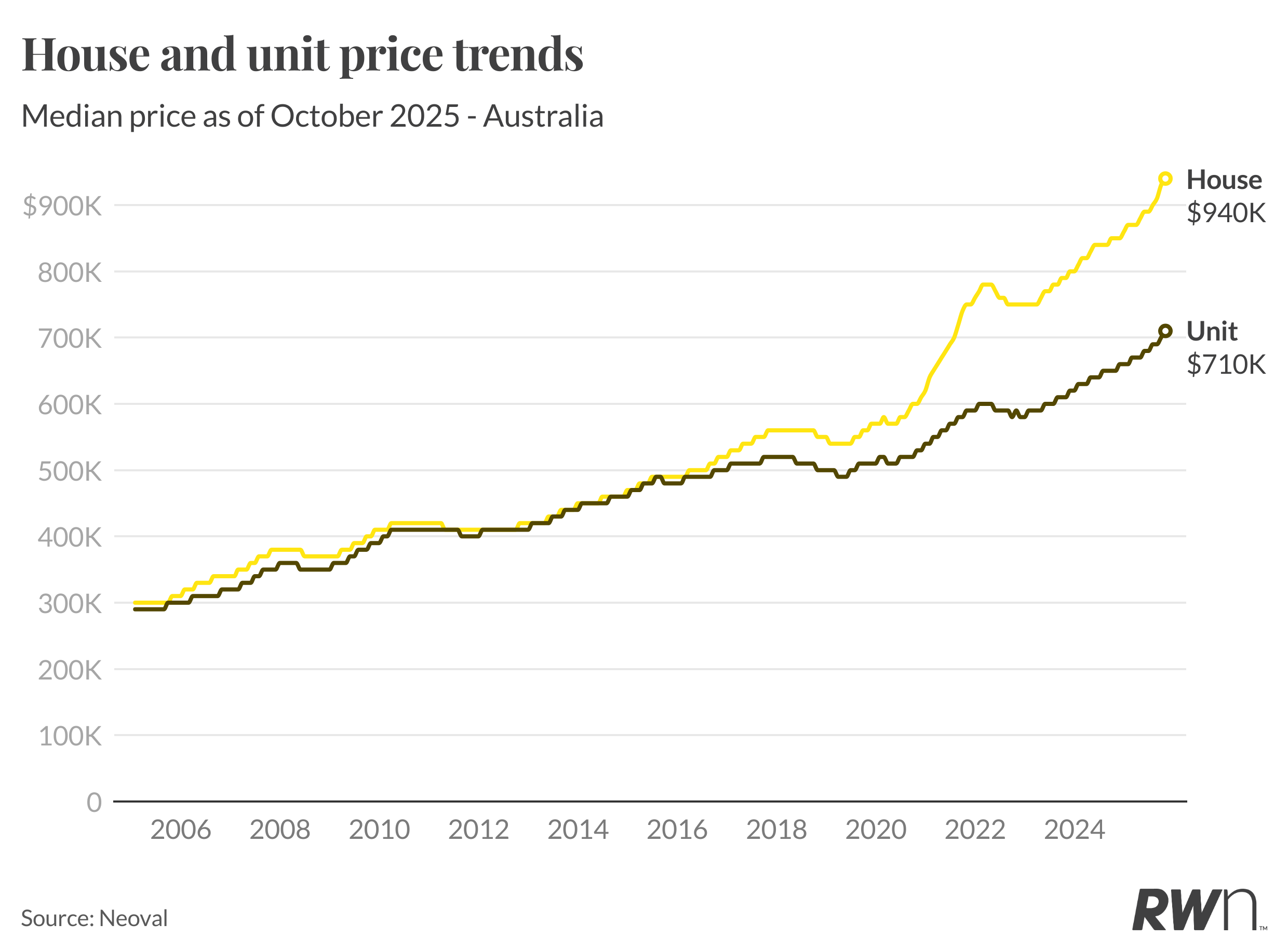
Units Outperform Houses
Unit prices rose even more sharply in October, up 1.4 per cent to $710,000, marking 9.2 per cent annual growth. Conisbee said affordability pressures, new first home buyer incentives, and a lack of available stock are pushing more buyers into the apartment market.
“Units are now seeing stronger monthly gains than houses, reflecting both affordability constraints and renewed first-home-buyer activity,” she said.
The biggest monthly jumps were in Perth (+1.6 per cent), Adelaide (+1.5 per cent), and Brisbane (+1.4 per cent). Melbourne’s unit market also firmed, up 1.6 per cent, as buyers returned to lower price brackets.
Spring Demand Defies Higher Listings
Despite an influx of spring listings, new stock has failed to match the intensity of buyer demand. Nationally, house prices have now risen every month since February, and unit prices every month since March.
“The pace of growth shows demand hasn’t been dampened by higher supply,” Conisbee said.
Outlook: Steady Growth Into 2026
The data comes as the Reserve Bank prepares for its Melbourne Cup Day meeting, where rates are expected to remain on hold at 3.6 per cent.
With inflation easing only gradually and unemployment sitting around 4.5 per cent, analysts expect monetary policy to stay steady for now.
Ray White’s forecast suggests 2025 will close with high single- to low double-digit annual growth nationally, with smaller capitals and regional areas tipped to outperform well into 2026.
From mud baths to herbal massages, Fiji’s heat rituals turned one winter escape into a soul-deep reset.
Ophora Tallawong has launched its final release of quality apartments priced under $700,000.









